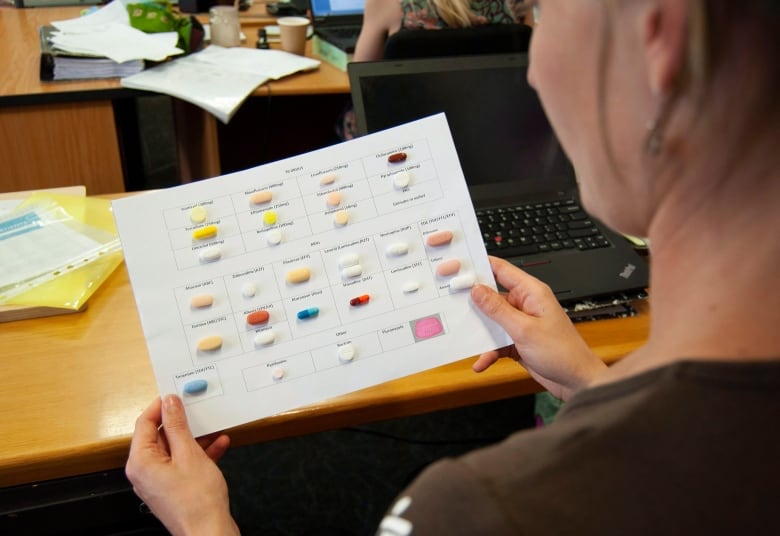Why overuse of antibiotics in COVID-19 could have lasting impact in health care
Canadian microbiologist says overuse of antibiotics in pandemic patients could have grave consequences

A leading Canadian microbiologist is sounding an alarm about overuse of precious antibiotics among the world's more than 8.7 million cases of COVID-19.
So many people have been seriously sickened by COVID-19 that they need to be cared for in hospital, such as with oxygen. Doctors commonly prescribe antibiotics for people with COVID-19 in hospital.
Eric Brown, a professor at the McMaster University's Institute of Infectious Disease Research, has concerns about how COVID-19 could drive up antibiotic resistance in bacteria that aren't killed by standard drugs.
"The biggest concern is for those who have COVID-19 who maybe don't need an antibiotic," he said.
Canadian infectious disease physicians say guidelines suggest a limited role for antibiotics in COVID-19 cases. Once it's clear that the person has COVID and there's no bacterial infection, then the antibiotic treatments should be stopped to avoid encouraging another infection in the same patient.
Bacterial resistance rates could lead to more deaths
Earlier this month, the director general of the World Health Organization, Tedros Adhanom Ghebreyesus, also expressed similar concerns.
"The COVID-19 pandemic has led to an increased use of antibiotics, which ultimately will lead to higher bacterial resistance rates that will impact the burden of disease and deaths during the pandemic and beyond," he said.
Brown said the long-term ramifications of the increase are unknown. They could jeopardize use of antimicrobials to prevent infections after surgeries like hip replacements, C-sections and organ transplants if bacteria in patients are resistant to them, he said.
The solution has two parts, he said: Stewardship — that is, only using antibiotics when needed — and discovering new antibiotics.
Yet scientists have not discovered any truly new classes of antibiotics in more than 50 years.

The Canada Council for the Arts recently awarded Brown a prestigious Killam Fellowship worth $70,000 a year for two years, which will allow the scientist to devote himself full time to a laboratory research project studying superbugs.
Brown hopes to change that by finding new antibiotics for what he called the top three dreaded superbugs on WHO's list. All three are classified as Gram-negative bacteria, which are characterized by having surfaces that are difficult for antibiotics to penetrate.
"There are a lot of clever approaches superbugs have to avoid antibiotics, and some of them are encoded by genes that are shared among pathogens," he said. "That's why antibiotic resistance can spread so widely."
Designer drug innovation
A biochemist by training, Brown is looking for a needle in a haystack among half a million chemicals that could crack the nut of the dreaded bacteria. Then, designer drugs could either kill the bacteria directly or slow them in their tracks.
"No one's really taken this approach," he said.
Brown is not daunted by how a new drug typically takes about 10 to 15 years from the discovery phase through clinical trials for safety and efficacy and on to the market.
His lab plans a series of experiments on screened compounds followed by chemical tinkering to improve potency of leading candidates for preclinical testing to decide whether an experimental drug, if found, should be tested in people.
Even then, challenges await.
"There isn't another therapeutic area in medicine where you would come up with what we call a designer drug and everybody would say, 'OK, that's fantastic. Let's almost never use it,'" Brown said.
Normally, pharmaceutical companies want to sell as much of their product as possible. But that's not necessarily the best model for antibiotics.

Instead, physicians in North America want to conserve antibiotics of last resort for increasingly resistant infections.
Dangerous trend needs to be countered
As the pandemic unfolds, doctors are still generally overprescribing antibiotics in many parts of the world.
But in low- and middle-income countries in Asia, Africa and South America, much less is known about how many antibiotics are prescribed by family physicians and why.
To start filling the gap, Dr. Giorgia Sulis, an infectious disease physician and doctoral candidate in epidemiology at McGill University, reviewed 10,000 studies with her team.
They whittled that down to just 16 studies with enough prescription details to gain a glimpse into the overuse problem with antibiotics. Their findings were published in the journal PLOS Medicine last week.
Sulis and her co-authors said they found the proportion of primary care patients seeking care for any reason who were prescribed antibiotics often exceeded 50 per cent, compared with the WHO's recommendation of less than 30 per cent for such patients.
When critical antibiotics are held reserve in Canada, they're used with caution in hospitals only, Sulis said.

Brown, who was not involved in the review, said it's "terrifying" to think about the "suspiciously high number" of antibiotics that were flagged.
Both Brown and Sulis recognize another consideration: the infectious disease burden in other parts of the world is also much higher than in Canada.
